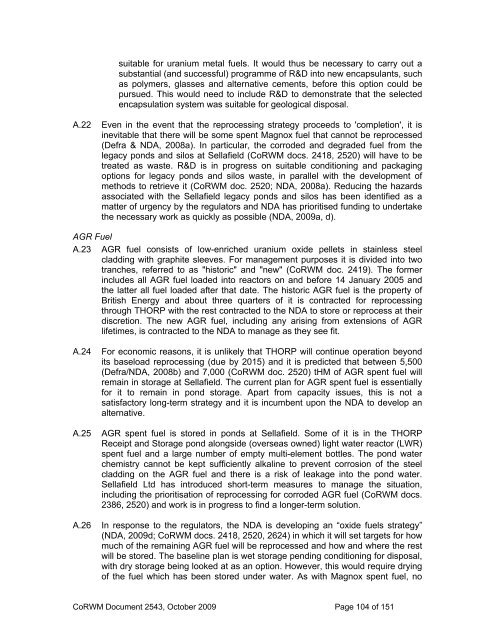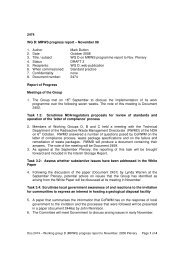2009 Report to Government on National Research and
2009 Report to Government on National Research and
2009 Report to Government on National Research and
- TAGS
- corwm.decc.gov.uk
Create successful ePaper yourself
Turn your PDF publications into a flip-book with our unique Google optimized e-Paper software.
suitable for uranium metal fuels. It would thus be necessary <str<strong>on</strong>g>to</str<strong>on</strong>g> carry out a<br />
substantial (<strong>and</strong> successful) programme of R&D in<str<strong>on</strong>g>to</str<strong>on</strong>g> new encapsulants, such<br />
as polymers, glasses <strong>and</strong> alternative cements, before this opti<strong>on</strong> could be<br />
pursued. This would need <str<strong>on</strong>g>to</str<strong>on</strong>g> include R&D <str<strong>on</strong>g>to</str<strong>on</strong>g> dem<strong>on</strong>strate that the selected<br />
encapsulati<strong>on</strong> system was suitable for geological disposal.<br />
A.22 Even in the event that the reprocessing strategy proceeds <str<strong>on</strong>g>to</str<strong>on</strong>g> 'completi<strong>on</strong>', it is<br />
inevitable that there will be some spent Magnox fuel that cannot be reprocessed<br />
(Defra & NDA, 2008a). In particular, the corroded <strong>and</strong> degraded fuel from the<br />
legacy p<strong>on</strong>ds <strong>and</strong> silos at Sellafield (CoRWM docs. 2418, 2520) will have <str<strong>on</strong>g>to</str<strong>on</strong>g> be<br />
treated as waste. R&D is in progress <strong>on</strong> suitable c<strong>on</strong>diti<strong>on</strong>ing <strong>and</strong> packaging<br />
opti<strong>on</strong>s for legacy p<strong>on</strong>ds <strong>and</strong> silos waste, in parallel with the development of<br />
methods <str<strong>on</strong>g>to</str<strong>on</strong>g> retrieve it (CoRWM doc. 2520; NDA, 2008a). Reducing the hazards<br />
associated with the Sellafield legacy p<strong>on</strong>ds <strong>and</strong> silos has been identified as a<br />
matter of urgency by the regula<str<strong>on</strong>g>to</str<strong>on</strong>g>rs <strong>and</strong> NDA has prioritised funding <str<strong>on</strong>g>to</str<strong>on</strong>g> undertake<br />
the necessary work as quickly as possible (NDA, <str<strong>on</strong>g>2009</str<strong>on</strong>g>a, d).<br />
AGR Fuel<br />
A.23 AGR fuel c<strong>on</strong>sists of low-enriched uranium oxide pellets in stainless steel<br />
cladding with graphite sleeves. For management purposes it is divided in<str<strong>on</strong>g>to</str<strong>on</strong>g> two<br />
tranches, referred <str<strong>on</strong>g>to</str<strong>on</strong>g> as "his<str<strong>on</strong>g>to</str<strong>on</strong>g>ric" <strong>and</strong> "new" (CoRWM doc. 2419). The former<br />
includes all AGR fuel loaded in<str<strong>on</strong>g>to</str<strong>on</strong>g> reac<str<strong>on</strong>g>to</str<strong>on</strong>g>rs <strong>on</strong> <strong>and</strong> before 14 January 2005 <strong>and</strong><br />
the latter all fuel loaded after that date. The his<str<strong>on</strong>g>to</str<strong>on</strong>g>ric AGR fuel is the property of<br />
British Energy <strong>and</strong> about three quarters of it is c<strong>on</strong>tracted for reprocessing<br />
through THORP with the rest c<strong>on</strong>tracted <str<strong>on</strong>g>to</str<strong>on</strong>g> the NDA <str<strong>on</strong>g>to</str<strong>on</strong>g> s<str<strong>on</strong>g>to</str<strong>on</strong>g>re or reprocess at their<br />
discreti<strong>on</strong>. The new AGR fuel, including any arising from extensi<strong>on</strong>s of AGR<br />
lifetimes, is c<strong>on</strong>tracted <str<strong>on</strong>g>to</str<strong>on</strong>g> the NDA <str<strong>on</strong>g>to</str<strong>on</strong>g> manage as they see fit.<br />
A.24 For ec<strong>on</strong>omic reas<strong>on</strong>s, it is unlikely that THORP will c<strong>on</strong>tinue operati<strong>on</strong> bey<strong>on</strong>d<br />
its baseload reprocessing (due by 2015) <strong>and</strong> it is predicted that between 5,500<br />
(Defra/NDA, 2008b) <strong>and</strong> 7,000 (CoRWM doc. 2520) tHM of AGR spent fuel will<br />
remain in s<str<strong>on</strong>g>to</str<strong>on</strong>g>rage at Sellafield. The current plan for AGR spent fuel is essentially<br />
for it <str<strong>on</strong>g>to</str<strong>on</strong>g> remain in p<strong>on</strong>d s<str<strong>on</strong>g>to</str<strong>on</strong>g>rage. Apart from capacity issues, this is not a<br />
satisfac<str<strong>on</strong>g>to</str<strong>on</strong>g>ry l<strong>on</strong>g-term strategy <strong>and</strong> it is incumbent up<strong>on</strong> the NDA <str<strong>on</strong>g>to</str<strong>on</strong>g> develop an<br />
alternative.<br />
A.25 AGR spent fuel is s<str<strong>on</strong>g>to</str<strong>on</strong>g>red in p<strong>on</strong>ds at Sellafield. Some of it is in the THORP<br />
Receipt <strong>and</strong> S<str<strong>on</strong>g>to</str<strong>on</strong>g>rage p<strong>on</strong>d al<strong>on</strong>gside (overseas owned) light water reac<str<strong>on</strong>g>to</str<strong>on</strong>g>r (LWR)<br />
spent fuel <strong>and</strong> a large number of empty multi-element bottles. The p<strong>on</strong>d water<br />
chemistry cannot be kept sufficiently alkaline <str<strong>on</strong>g>to</str<strong>on</strong>g> prevent corrosi<strong>on</strong> of the steel<br />
cladding <strong>on</strong> the AGR fuel <strong>and</strong> there is a risk of leakage in<str<strong>on</strong>g>to</str<strong>on</strong>g> the p<strong>on</strong>d water.<br />
Sellafield Ltd has introduced short-term measures <str<strong>on</strong>g>to</str<strong>on</strong>g> manage the situati<strong>on</strong>,<br />
including the prioritisati<strong>on</strong> of reprocessing for corroded AGR fuel (CoRWM docs.<br />
2386, 2520) <strong>and</strong> work is in progress <str<strong>on</strong>g>to</str<strong>on</strong>g> find a l<strong>on</strong>ger-term soluti<strong>on</strong>.<br />
A.26 In resp<strong>on</strong>se <str<strong>on</strong>g>to</str<strong>on</strong>g> the regula<str<strong>on</strong>g>to</str<strong>on</strong>g>rs, the NDA is developing an “oxide fuels strategy”<br />
(NDA, <str<strong>on</strong>g>2009</str<strong>on</strong>g>d; CoRWM docs. 2418, 2520, 2624) in which it will set targets for how<br />
much of the remaining AGR fuel will be reprocessed <strong>and</strong> how <strong>and</strong> where the rest<br />
will be s<str<strong>on</strong>g>to</str<strong>on</strong>g>red. The baseline plan is wet s<str<strong>on</strong>g>to</str<strong>on</strong>g>rage pending c<strong>on</strong>diti<strong>on</strong>ing for disposal,<br />
with dry s<str<strong>on</strong>g>to</str<strong>on</strong>g>rage being looked at as an opti<strong>on</strong>. However, this would require drying<br />
of the fuel which has been s<str<strong>on</strong>g>to</str<strong>on</strong>g>red under water. As with Magnox spent fuel, no<br />
CoRWM Document 2543, Oc<str<strong>on</strong>g>to</str<strong>on</strong>g>ber <str<strong>on</strong>g>2009</str<strong>on</strong>g> Page 104 of 151



